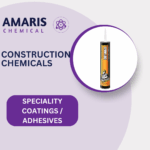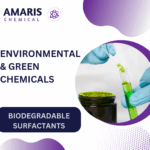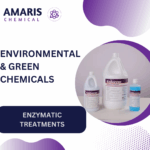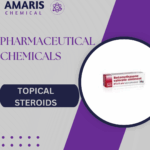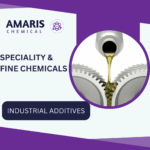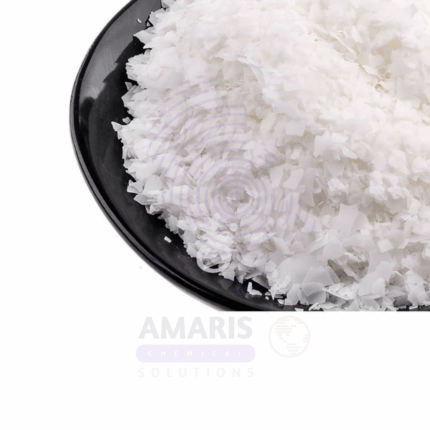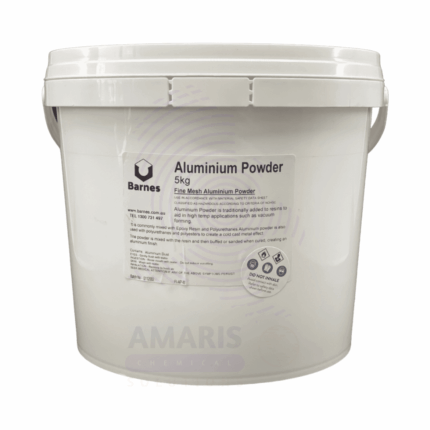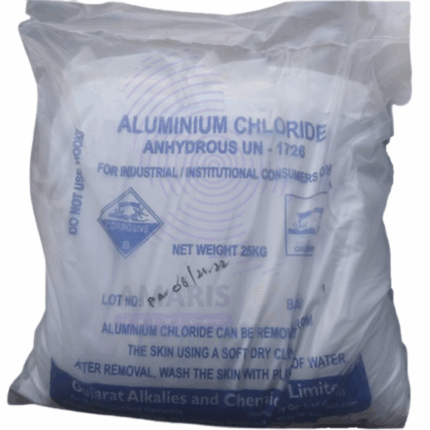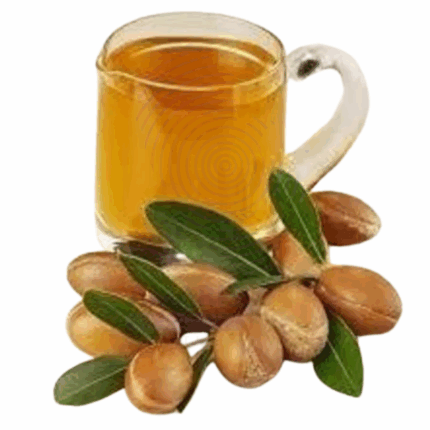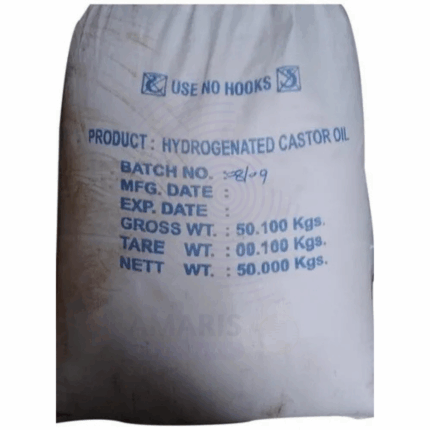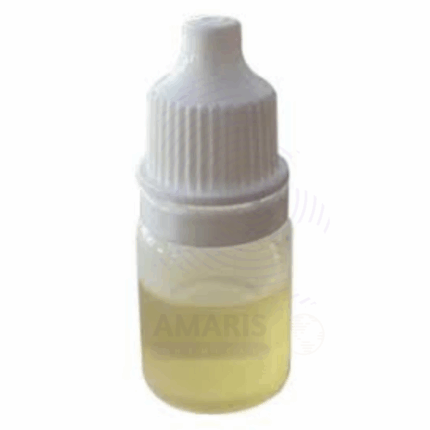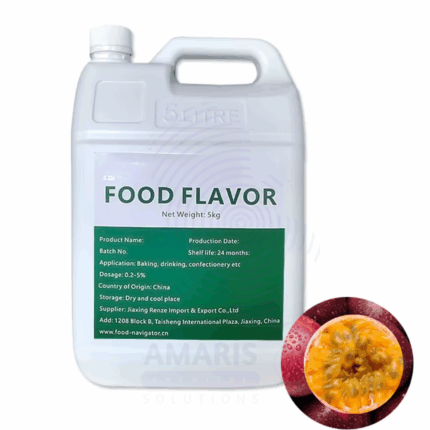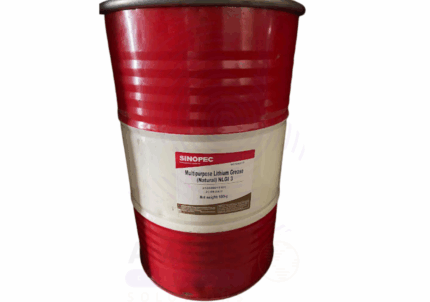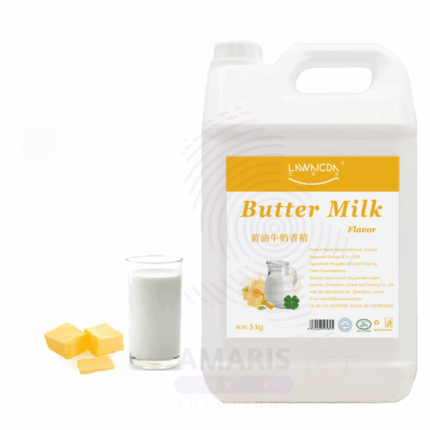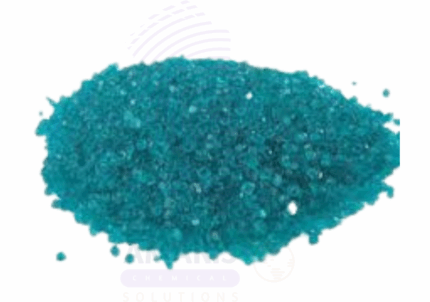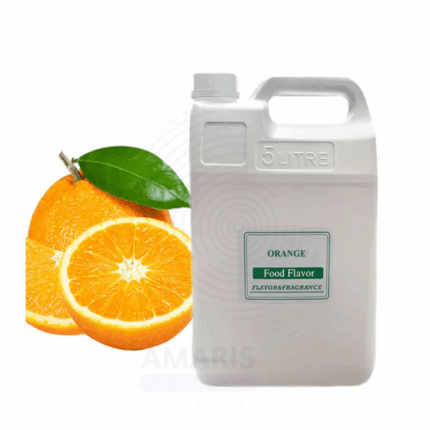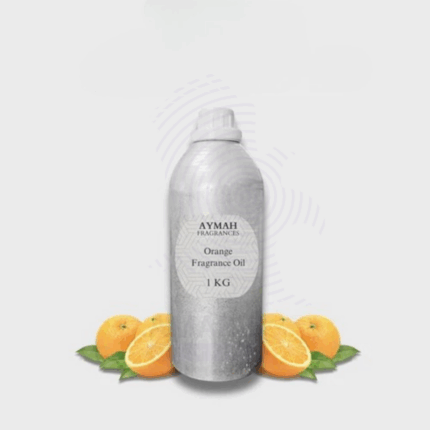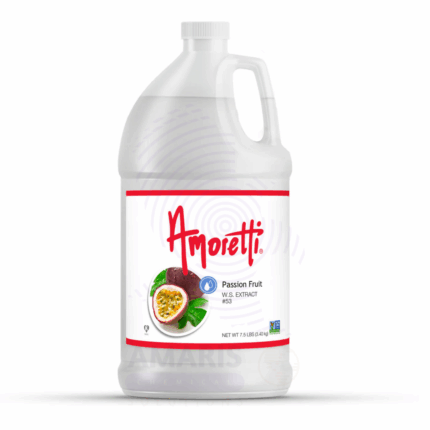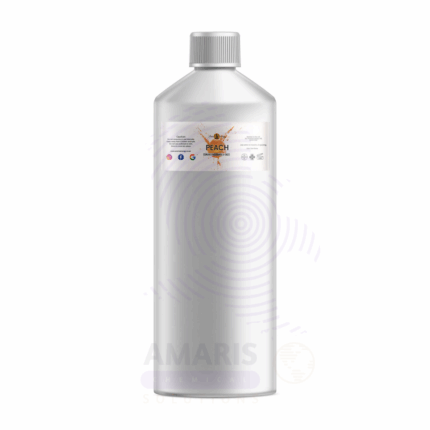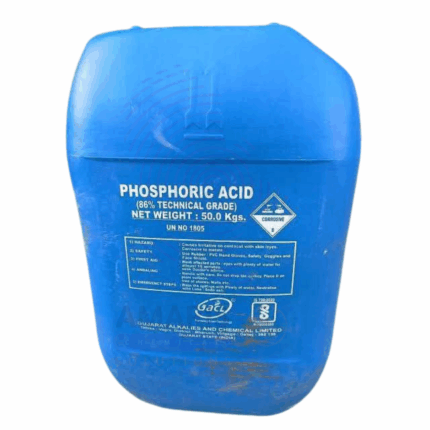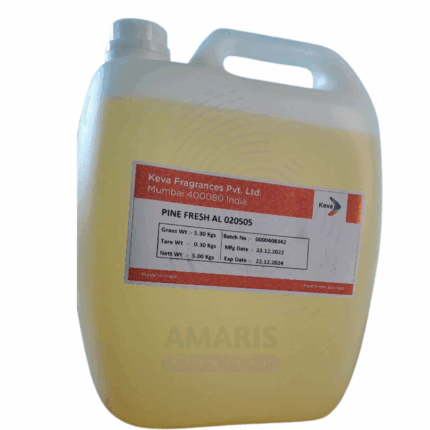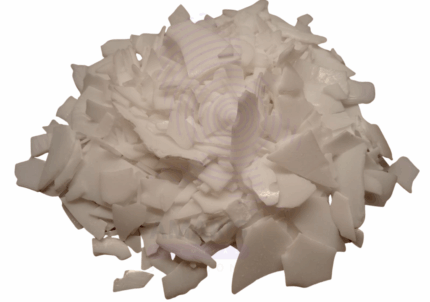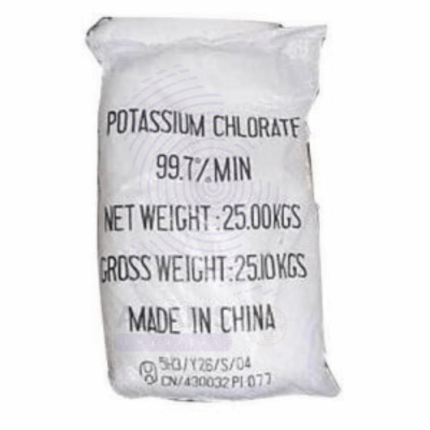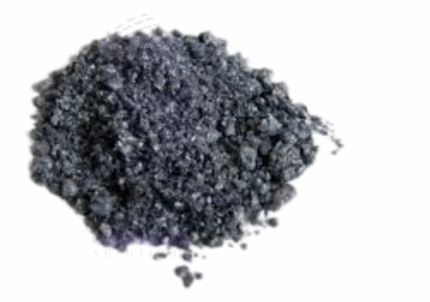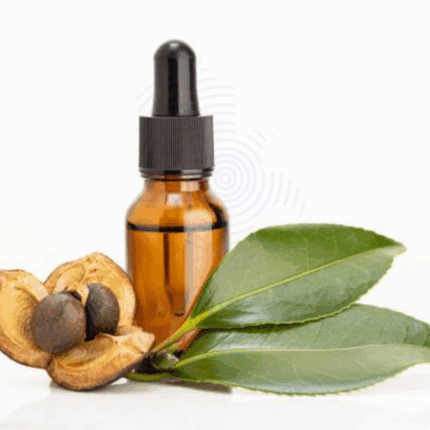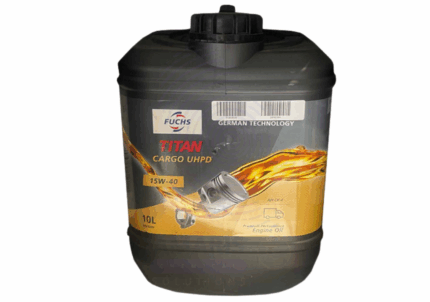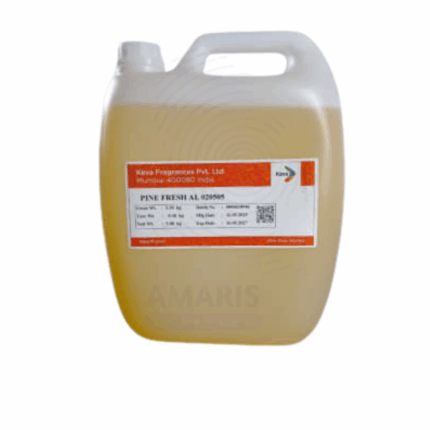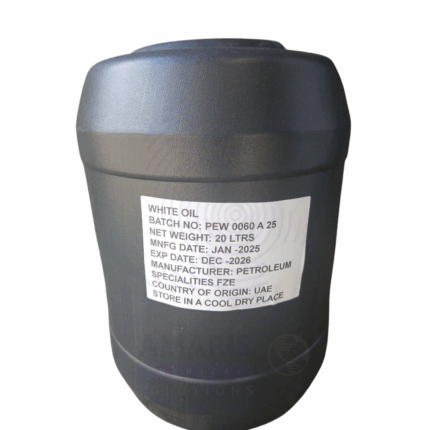
Almond Wax
Almond Wax is a natural, plant-based wax derived from the hydrogenation of almond oil (Prunus amygdalus dulcis). It is a creamy to white, semi-solid wax with a mild, nutty scent and excellent emollient properties. Almond Wax is rich in fatty acids and has a smooth, soft texture, making it ideal for use in cosmetic, personal care, and candle formulations.
Due to its gentle consistency, skin-friendly profile, and moisturizing capabilities, Almond Wax is widely used in body butters, balms, lip care products, massage bars, and artisan soaps. It functions as a natural alternative to petroleum-based waxes and provides structure, viscosity, and glide to formulations. It also finds application in soft wax blends for natural candle products.
Ammonium Cupric Chloride
Ammonium Cupric Chloride is a blue-green crystalline inorganic compound composed of copper, ammonium, and chloride ions. It is widely used as a source of copper in agricultural fungicides and bactericides, as well as in electroplating, chemical synthesis, and textile dyeing. Its antimicrobial properties make it valuable for controlling fungal and bacterial infections in plants. Additionally, it serves as a precursor in various industrial and laboratory applications.
Anhydrous Aluminum Chloride
Anhydrous Aluminum Chloride (AlCl₃) is a white to pale yellow crystalline solid known for its strong Lewis acid properties. It is a key catalyst widely used in organic synthesis, especially in Friedel-Crafts alkylation and acylation reactions. Due to its high reactivity with moisture, it must be stored and handled under strictly anhydrous conditions. Anhydrous Aluminum Chloride also finds applications in polymerization, pharmaceuticals, and the production of dyes, pharmaceuticals, and petrochemicals.
Barium Nitrate
Barium Nitrate is an inorganic chemical compound, a white crystalline solid composed of barium and nitrate ions. It is highly soluble in water and serves as an oxidizing agent. Due to its energetic properties, barium nitrate is widely used in pyrotechnics to produce vibrant green colors and as an oxidizer in explosives and fireworks. It is also utilized in the manufacturing of barium oxide and other barium compounds. Barium nitrate must be handled carefully due to its toxicity and oxidizing nature.
Cade Crude 2 Oil
Cade Crude 2 Oil is a dark, viscous essential oil obtained through destructive distillation of the wood of the Juniperus oxycedrus tree (also known as prickly juniper). Known for its intense smoky, tar-like aroma and antiseptic qualities, this crude-grade cade oil is widely used in traditional skin remedies, veterinary care, and industrial cosmetic applications—especially in products aimed at treating chronic skin conditions such as psoriasis, eczema, and dandruff.
While not as refined as rectified Cade oil, Cade Crude 2 Oil retains a high concentration of phenols, cresols, and other active compounds that contribute to its strong antimicrobial, antifungal, and antipruritic effects. It is used cautiously in topical formulations at low dilution levels and is valued in rustic and smoky fragrance compositions.
Ferric Ammonium Citrate
Ferric Ammonium Citrate is a dark green to black crystalline or granular inorganic compound composed of iron, ammonium ions, and citrate ions. It is a complex salt of citric acid with ferric iron (Fe³⁺) and ammonium. This compound is highly soluble in water, forming a greenish solution, and is widely utilized as a source of iron in various chemical, pharmaceutical, photographic, and food applications. It acts as a mild oxidizing agent and an iron supplement, valued for its bioavailability and ease of incorporation into formulations. Ferric Ammonium Citrate is typically available in different formulations distinguished by their water and ammonium content, such as green and brown types.
Fuel Conditioner
Fuel Conditioner is a specialized chemical additive formulated to improve the performance, efficiency, and longevity of fuels such as gasoline, diesel, biodiesel, and kerosene. It typically contains detergents, corrosion inhibitors, stabilizers, lubricity enhancers, and combustion improvers. The product is designed to clean fuel injectors and carburetors, reduce engine deposits, prevent fuel oxidation, and enhance combustion efficiency. Fuel Conditioners help optimize fuel properties to reduce emissions, improve fuel economy, and protect fuel system components in vehicles, generators, and industrial machinery.
Hydrogenated Castor Oil
Hydrogenated Castor Oil, also known as castor wax, is a hard, brittle, and high-melting-point wax derived by the hydrogenation of pure castor oil. This white to off-white, odorless substance is non-toxic and insoluble in water but dispersible in surfactant systems. Its primary component is hydrogenated ricinoleic acid triglyceride, and it is prized for its excellent lubricating, emulsifying, thickening, and consistency-enhancing properties.
Due to its stability, non-reactivity, and film-forming capability, Hydrogenated Castor Oil is widely used in cosmetics, personal care, pharmaceuticals, industrial lubricants, coatings, plastics, and more. It improves product texture, enhances emulsion stability, and provides moisture retention in skincare applications.
Immersion Oil
Immersion Oil is a high-purity, optically transparent oil used primarily in microscopy to enhance the resolution of high-power objectives. Applied between the microscope objective lens and the cover glass, immersion oil reduces light refraction and increases numerical aperture, allowing for clearer and more detailed imaging. It is colorless, non-drying, and has a refractive index closely matching that of glass (typically around 1.515).
This 50ml volume is ideal for laboratory, clinical, and educational settings where precision microscopy work is performed. Immersion oil is formulated to be chemically stable, non-drying, and safe for delicate optics when used correctly.
Induction coil
An induction coil is an electrical transformer used to produce high-voltage pulses from a low-voltage direct current (DC) supply. It consists of two coils of wire—primary and secondary—wound around a common iron core. When current passes through the primary coil, it creates a magnetic field that induces a high voltage in the secondary coil. Induction coils are essential components in ignition systems, spark generation, and scientific experiments requiring high-voltage pulses.
Commonly used in automotive ignition systems, laboratory equipment, and electromagnetic experiments, induction coils enable the conversion of low voltage to the high voltage necessary to generate sparks or initiate other electrical discharges.
Light White Mineral Oil Tech Grade
Light White Mineral Oil Tech Grade is a highly refined, colorless, odorless, and tasteless petroleum-derived oil. It is characterized by its low viscosity and excellent lubricating properties. This technical-grade mineral oil undergoes stringent purification processes to remove impurities, making it suitable for various industrial, cosmetic, pharmaceutical, and food-related applications. Its chemical stability, non-reactivity, and safety profile make it a versatile ingredient and lubricant in many manufacturing and processing sectors.
Liquid Paraffin
Liquid Paraffin, also known as mineral oil, is a clear, colorless, odorless, and tasteless petroleum-derived liquid hydrocarbon. It is composed primarily of saturated hydrocarbons and is highly refined to meet pharmaceutical and cosmetic grade standards. Liquid Paraffin is widely used for its lubricating, moisturizing, and protective properties. It is non-volatile, chemically stable, and insoluble in water, making it ideal for applications in personal care, pharmaceuticals, and industrial lubrication.
Liquid Passion Fruit Flavour
Liquid Passion Fruit Flavour is a vibrant and tangy flavoring designed to replicate the exotic and refreshing taste of ripe passion fruit. This high-quality flavor is extensively used in the food and beverage industry to enhance products such as juices, smoothies, confectionery, dairy, and baked goods. It dissolves well in both water and alcohol, offering versatility in various formulations. Its authentic tropical aroma and taste help manufacturers create appealing products that satisfy consumer preferences for fruity and refreshing flavors.
Liquid Pineapple Flavor food grade
Liquid Pineapple Flavor (Food Grade) is a high-quality, natural and synthetic flavoring agent designed to capture the sweet, tangy, and refreshing taste of ripe pineapple. Widely used in the food and beverage industry, this flavor enhances a variety of products such as soft drinks, juices, confectionery, dairy, and baked goods. It is water and alcohol soluble, providing versatility in formulation. Its vibrant tropical aroma and authentic pineapple taste help create appealing and flavorful consumer products.
Liquid strawberry flavor food grade
Liquid Strawberry Flavor (Food Grade) is a premium quality flavoring agent that captures the fresh, sweet, and slightly tart essence of ripe strawberries. Widely used in the food and beverage industry, this flavor enhances the taste and aroma of a variety of products including beverages, confectionery, dairy, and baked goods. It is water and alcohol soluble, allowing easy incorporation into multiple formulations. The natural and authentic strawberry profile makes it ideal for creating flavorful and appealing consumer products.
Liquid Vanilla flavor food grade
Liquid Vanilla Flavor (Food Grade) is a high-quality, natural and synthetic blend designed to provide the rich, creamy, and sweet aroma characteristic of vanilla beans. Widely used in the food and beverage industry, this versatile flavoring enhances the taste profile of baked goods, dairy products, beverages, and confectionery. Its excellent solubility in water and alcohol allows for easy incorporation into a wide range of formulations. Liquid Vanilla Flavor offers a smooth, authentic vanilla note that improves product appeal and consumer satisfaction.
Lithium Grease
Lithium Grease is a multi-purpose, high-performance lubricant made by thickening mineral or synthetic oils with lithium soap as the thickening agent. It exhibits excellent mechanical stability, water resistance, and oxidation resistance, making it suitable for a wide range of industrial, automotive, and household lubrication applications. Lithium Grease is valued for its high dropping point, good adhesion, and ability to perform under varying temperature and load conditions.
Mango Candy Liquid Flavour
Mango Candy Liquid Flavour is a vibrant, sweet, and tropical mango-flavored liquid designed specifically for confectionery applications. This flavoring captures the juicy, tangy essence of ripe mangoes combined with the sugary notes typical of candy, making it ideal for enhancing the taste and aroma of candies, chewing gums, and sweets. Its excellent solubility in water and alcohol facilitates easy incorporation into various food and beverage formulations. Mango Candy Liquid Flavor provides a refreshing and appealing mango candy experience that delights consumers of all ages.
Mango Liquid Flavor food grade
Mango Liquid Flavor Food Grade is a vibrant and natural-tasting flavoring agent that replicates the sweet, juicy, and tropical essence of ripe mangoes. This high-quality liquid flavor is specially formulated for use in food and beverage applications, providing a consistent and authentic mango aroma and taste. Its excellent solubility and stability make it ideal for use in beverages, confectionery, dairy products, baked goods, and other food formulations, enhancing product appeal with a fresh tropical note.
Milk Butter Liquid Flavour
Milk Butter Liquid Flavour is a rich and creamy flavoring agent designed to replicate the smooth, savory taste of fresh milk and real butter. This food-grade flavor is widely used in the food and beverage industry to impart a full-bodied dairy profile, adding indulgent and comforting notes to various products. Its excellent solubility, thermal stability, and compatibility with both sweet and savory formulations make it an ideal ingredient in bakery goods, confectionery, dairy-based products, and sauces. It enhances overall flavor depth and mouthfeel in both processed and gourmet food items.
Mono Ethylene Glycol
Mono Ethylene Glycol (MEG) is a colorless, odorless, viscous liquid with a sweet taste. It is a widely used organic compound belonging to the glycol family. MEG is primarily utilized as an antifreeze agent and a raw material in the production of polyester fibers and resins. Its excellent solvent properties, low volatility, and high boiling point make it valuable across various industrial applications.
Nivea Type Fragrance Oil
Nivea Type Fragrance Oil is a premium-grade aromatic oil formulated to mimic the clean, soft, and classic scent profile associated with Nivea skincare products. This fragrance features a balanced blend of fresh florals, creamy musk, and light powdery undertones that evoke feelings of comfort, care, and softness. It is widely used in cosmetic and personal care formulations, as well as in household products where a gentle, soothing scent is desired. Due to its stability and compatibility, it can be incorporated into a variety of oil-based or water-based systems.
Orange Concentrate Liquid Flavour
Orange Concentrate Liquid Flavour is a highly concentrated, food-grade flavoring agent designed to deliver the fresh, tangy, and sweet citrus profile of ripe oranges. This liquid flavor is widely used in food and beverage manufacturing due to its vibrant taste, excellent solubility, and ability to retain flavor integrity even under heat or processing stress. It is ideal for applications ranging from beverages, confectionery, and baked goods to dairy and dessert products. Its intense citrus character enhances both natural and artificially flavored food formulations.
Orange Fragrance Oil
Orange Fragrance Oil is a highly concentrated aromatic oil that delivers a fresh, vibrant, and sweet citrus scent reminiscent of ripe oranges. It is formulated for use in a variety of applications including personal care products, household items, and air fresheners. This fragrance oil offers excellent scent throw, stability, and compatibility with different base materials such as waxes, solvents, and emulsions. Its refreshing aroma makes it a popular choice for perfuming soaps, candles, detergents, and cosmetic formulations, providing a natural and uplifting citrus experience.
Orbit LCD
Orbit LCD is a concentrated liquid chemical dispersant designed to improve the dispersion of pigments, fillers, and other particulate materials in coatings, paints, inks, and adhesives. It enhances color uniformity, stability, and rheological properties of formulations by reducing particle agglomeration and sedimentation. With excellent compatibility in waterborne and solvent-based systems, Orbit LCD 48% is widely used in industrial and decorative coatings for optimal performance.
Passion Fragrance Water Soluble
Passion Fragrance Water Soluble is a fresh and vibrant fragrance designed to deliver the sweet, tropical aroma of passion fruit in water-based formulations. Its excellent solubility in water makes it ideal for use in a variety of cosmetic, personal care, and household products such as body sprays, lotions, shampoos, and air fresheners. This fragrance oil is formulated to maintain scent stability and longevity in aqueous systems while providing a clean, refreshing tropical note. Manufactured under strict quality standards, it ensures consistent performance and safety for various applications.
Passion Fruit Fragrance Oil
Passion Fruit Fragrance Oil is a vibrant, richly scented oil delivering the sweet, exotic aroma of ripe passion fruit. Ideal for enhancing personal care products, perfumes, and home fragrances, this fragrance oil provides a long-lasting, fresh tropical scent. It is crafted to blend smoothly into oil-based and solvent-based formulations, ensuring consistent fragrance delivery. Manufactured under stringent quality controls, Passion Fruit Fragrance Oil adds a luxurious and refreshing note to a wide range of applications.
Peach Fragrance Oil
Peach Fragrance Oil is a sweet, fruity, and soft aroma compound designed to mimic the scent of ripe, juicy peaches. It is widely used in personal care products, cosmetics, and home fragrance applications, providing a refreshing and appealing note. This fragrance oil is carefully formulated to deliver a long-lasting scent and is compatible with both oil-based and solvent-based systems. Ideal for use in candles, soaps, lotions, perfumes, and cleaning products, Peach Fragrance Oil ensures consistent quality, fragrance stability, and sensory appeal across a wide range of uses.
Phosphoric acid Technical Grade
Phosphoric Acid Technical Grade is a concentrated, inorganic acid primarily used in industrial applications. It typically contains minor impurities compared to food or pharmaceutical grades but maintains excellent performance as an acidulant, rust remover, and intermediate chemical. This grade is widely used in manufacturing fertilizers, detergents, metal treatment, and other industrial processes where high purity is not critical but effective acidic properties are required.
Pine Fresh Fragrance Oil
Pine Fresh Fragrance Oil is a synthetic fragrance blend designed to replicate the crisp, fresh, and invigorating scent of pine forests. It combines green, woody, and subtle earthy notes to deliver a clean and natural aroma. This fragrance oil is highly stable in both oil- and alcohol-based formulations and retains its scent integrity under high-temperature processing. Pine Fresh Fragrance Oil is widely used in personal care, household, and industrial applications for its long-lasting, refreshing pine scent that enhances product appeal and consumer experience. It is compatible with a variety of product bases and maintains performance over extended storage periods.
Polyvinyl Chloride PE Wax
Polyvinyl Chloride PE Wax is a polyethylene-based wax additive used in PVC formulations to improve processing, lubrication, and surface finish. It serves as an internal and external lubricant in both rigid and flexible PVC products, enhancing extrusion, molding, and calendaring operations. It also contributes to better dispersion of fillers and pigments, reduced friction, and improved thermal stability. PE Wax for PVC is available in powder, flake, or granule form and is valued for its compatibility, thermal resistance, and cost-effectiveness.
Potassium Chlorate
Potassium Chlorate is a strong oxidizing agent and crystalline chemical compound widely used in various industrial, laboratory, and commercial applications. It appears as a white, odorless, and water-soluble solid. Potassium Chlorate serves primarily as a source of oxygen in chemical reactions and is critical in the manufacture of explosives, matches, fireworks, and disinfectants. Due to its reactive nature, it requires careful handling and storage.
Potassium Nitrate
Potassium Nitrate is a white crystalline salt commonly known as saltpeter. It is a key oxidizing agent widely used in fertilizers, food preservation, pyrotechnics, and chemical manufacturing. Potassium Nitrate provides essential potassium and nitrogen nutrients in agriculture and acts as a source of oxygen in combustion reactions. Its stability and solubility make it valuable across various industries from agriculture to explosives.
Renisco KCS 68
Renisco KCS 68 is a clay-coated, controlled-release potassium sulfate fertilizer granule containing approximately 68% K₂O equivalent. The clay coating regulates potassium release, aligning nutrient availability with plant uptake over an extended period. This minimizes leaching and enhances nutrient-use efficiency. Renisco KCS 68 is widely used in horticulture, agriculture, turf management, and specialty crop production.
Renolin B
Renolin B is a high-quality mineral oil-based lubricant commonly used as a hydraulic oil, compressor oil, and general-purpose industrial lubricant. It features excellent oxidation stability, good thermal properties, and effective anti-wear performance. Renolin B is suitable for a wide range of industrial machinery and equipment, providing reliable lubrication, corrosion protection, and extended service life under moderate operating conditions
Salcromo
Salcromo is a specialty chemical used primarily as a corrosion inhibitor and surface treatment agent for metals. It helps prevent rust and corrosion on metal surfaces, enhancing their durability and lifespan. Salcromo is widely applied in industries such as metal finishing, automotive, and manufacturing to protect steel, iron, and other metals from environmental damage and oxidation.
Sassafras Oil
Sassafras Oil is a potent essential oil distilled primarily from the bark of the Sassafras albidum tree, native to North America. Steam distillation yields a yellow to reddish-brown oil with a strong, sweet, root beer–like aroma due to its primary constituent, safrole. Historically used in perfumery, flavoring, and herbal medicine, Sassafras Oil possesses aromatic, antiseptic, and stimulant properties.
Despite its traditional applications, safrole-containing Sassafras Oil is strictly regulated in many countries due to potential hepatotoxicity and carcinogenicity associated with safrole. As such, modern uses are limited, and safrole-free versions are required for legal use in personal care or flavoring. In compliant forms, it finds niche use in natural fragrances, industrial solvents, and botanical extracts.
Silicon Emulsion
Silicon Emulsion is a stable, water-based emulsion of polydimethylsiloxane (PDMS) or other silicone fluids, commonly used for lubrication, gloss enhancement, release, water repellency, and surface conditioning. It appears as a milky-white, viscous liquid and is non-toxic, non-flammable, and easy to handle. Due to its excellent spreadability and low surface tension, it is widely used in industries ranging from automotive and textiles to agriculture, construction, and cosmetics.
Sodium Formate Industrial Grade
Sodium Formate Industrial Grade is a white crystalline powder or granules used primarily in industrial applications requiring a buffering agent, de-icing agent, or chemical intermediate. It offers high purity suitable for various manufacturing processes but does not meet food-grade standards. This grade is widely applied in leather tanning, textile dyeing, concrete additives, and as a corrosion inhibitor in oil and gas industries.
Sodium Nitrate (25kg)
Sodium Nitrate is an inorganic white crystalline solid with the chemical formula NaNO₃. This 25kg packaged industrial-grade product serves as a powerful oxidizing agent and nitrogen source, widely used in fertilizers, pyrotechnics, food preservation, and chemical manufacturing. Its high solubility and stability make it ideal for controlled oxidation processes and nitrate salt production.
Titan Power 40 SAE
Titan Power 40 SAE is a high-performance monograde engine oil formulated for diesel and gasoline engines operating under moderate to severe conditions. Classified as SAE 40 by the Society of Automotive Engineers, this oil offers excellent thermal stability, wear protection, and oxidation resistance. It is particularly suited for older-generation engines and equipment in on-road, off-road, industrial, and marine environments where SAE 40 is specified. The formulation ensures reliable lubrication, engine cleanliness, and extended engine life.
Unipine Fragrance Water Soluble
Unipine Fragrance Water Soluble is a fresh, crisp, pine-based aromatic compound formulated for use in water-based systems. It replicates the clean, invigorating scent of pine forests with subtle herbal and woody undertones, making it a popular choice in air fresheners, cleaning agents, and personal care formulations. Its water-soluble nature allows for easy incorporation into aqueous products without the need for emulsifiers, ensuring even fragrance dispersion and stability. Unipine fragrance offers excellent performance in both homecare and hygiene applications where a natural, clean aroma is desired.
White Oil
White Oil, also known as Mineral Oil or Liquid Paraffin, is a highly refined, clear, odorless, and tasteless petroleum-derived oil. It is composed of saturated aliphatic hydrocarbons and is available in various viscosity grades depending on the intended application. The product is extensively purified to remove aromatic hydrocarbons, sulfur compounds, and other impurities, making it suitable for use in personal care, pharmaceutical, food, and industrial applications. White Oil is prized for its excellent lubricity, moisture barrier function, chemical stability, and non-comedogenic properties.
White Oil supplied in a 162 kg drum format is typically used in bulk manufacturing and industrial-scale processing across multiple sectors.


 Preservatives(food)
Preservatives(food) Flavor Enhancers
Flavor Enhancers Acidulants
Acidulants Sweeteners
Sweeteners Antioxidants
Antioxidants Colorants(food)
Colorants(food) Nutraceutical Ingredients (food)
Nutraceutical Ingredients (food) Nutrient Supplements
Nutrient Supplements Emulsifiers
Emulsifiers
 Collectors
Collectors Dust Suppressants
Dust Suppressants Explosives and Blasting Agents
Explosives and Blasting Agents Flocculants and Coagulants
Flocculants and Coagulants Frothers
Frothers Leaching Agents
Leaching Agents pH Modifiers
pH Modifiers Precious Metal Extraction Agents
Precious Metal Extraction Agents
 Antioxidants(plastic)
Antioxidants(plastic) Colorants (Pigments, Dyes)
Colorants (Pigments, Dyes) Fillers and Reinforcements
Fillers and Reinforcements Flame Retardants
Flame Retardants Monomers
Monomers Plasticizers
Plasticizers Polymerization Initiators
Polymerization Initiators Stabilizers (UV, Heat)
Stabilizers (UV, Heat)
 Antifoaming Agents
Antifoaming Agents Chelating Agents
Chelating Agents Coagulants and Flocculants
Coagulants and Flocculants Corrosion Inhibitors
Corrosion Inhibitors Disinfectants and Biocides
Disinfectants and Biocides Oxidizing Agents
Oxidizing Agents pH Adjusters
pH Adjusters Scale Inhibitors( water)
Scale Inhibitors( water)
 Antioxidants(cosmetic)
Antioxidants(cosmetic) Emollients
Emollients Fragrances and Essential Oils
Fragrances and Essential Oils Humectants
Humectants Preservatives
Preservatives Surfactants(cosmetic)
Surfactants(cosmetic) Thickeners
Thickeners UV Filters
UV Filters
 Fertilizers
Fertilizers Soil Conditioners
Soil Conditioners Plant Growth Regulators
Plant Growth Regulators Animal Feed Additives
Animal Feed Additives Biostimulants
Biostimulants Pesticides (Herbicides, Insecticides, Fungicides)
Pesticides (Herbicides, Insecticides, Fungicides)
 Active Pharmaceutical Ingredients (APIs)
Active Pharmaceutical Ingredients (APIs) Excipients
Excipients Solvents(pharmaceutical)
Solvents(pharmaceutical) Antibiotics
Antibiotics Antiseptics and Disinfectants
Antiseptics and Disinfectants Vaccine Adjuvants
Vaccine Adjuvants Nutraceutical Ingredients (pharmaceutical)
Nutraceutical Ingredients (pharmaceutical) Analgesics & Antipyretics
Analgesics & Antipyretics
 Analytical Reagents
Analytical Reagents Solvents(lab)
Solvents(lab) Chromatography Chemicals
Chromatography Chemicals Spectroscopy Reagents
Spectroscopy Reagents microbiology-and-cell-culture-reagents
microbiology-and-cell-culture-reagents Molecular Biology Reagents
Molecular Biology Reagents Biochemical Reagents
Biochemical Reagents Inorganic and Organic Standards
Inorganic and Organic Standards Laboratory Safety Chemicals
Laboratory Safety Chemicals Specialty Laboratory Chemicals(Special Laboratory Equipment)
Specialty Laboratory Chemicals(Special Laboratory Equipment)
 Demulsifiers
Demulsifiers Hydraulic Fracturing Fluids
Hydraulic Fracturing Fluids Scale Inhibitors(oil)
Scale Inhibitors(oil) Surfactants(oil)
Surfactants(oil) Drilling Fluids
Drilling Fluids
 Dyes and Pigments
Dyes and Pigments Bleaching Agents
Bleaching Agents Softening Agents
Softening Agents Finishing Agents
Finishing Agents Antistatic Agents
Antistatic Agents
 Admixtures
Admixtures Waterproofing Agents
Waterproofing Agents Sealants and Adhesives
Sealants and Adhesives Curing Compounds
Curing Compounds Concrete Repair Chemicals
Concrete Repair Chemicals Anti-Corrosion Coatings
Anti-Corrosion Coatings
 Surfactants(cleaning)
Surfactants(cleaning) Builders
Builders Enzymes
Enzymes Solvents (Cleaning)
Solvents (Cleaning) Fragrances
Fragrances
 Electronic Chemicals
Electronic Chemicals Catalysts
Catalysts Lubricants
Lubricants Photographic Chemicals
Photographic Chemicals Refrigerants
Refrigerants Automotive chemicals
Automotive chemicals Pyrotechnic Chemicals
Pyrotechnic Chemicals
 Biodegradable Surfactants
Biodegradable Surfactants Bio-based Solvents
Bio-based Solvents Renewable Polymers
Renewable Polymers Carbon Capture Chemicals
Carbon Capture Chemicals Wastewater Treatment Chemicals
Wastewater Treatment Chemicals
 Pigments
Pigments Solvents(paint)
Solvents(paint) Specialty Coatings
Specialty Coatings Binders/Resins
Binders/Resins Additives
Additives Driers
Driers Anti-Corrosion Agents
Anti-Corrosion Agents Functional Coatings
Functional Coatings Application-Specific Coatings
Application-Specific Coatings
 Fresh Herbs
Fresh Herbs Ground Spices
Ground Spices Whole Spices
Whole Spices Spice Blends
Spice Blends Dried Herbs
Dried Herbs
 Leavening Agents
Leavening Agents Dough Conditioners
Dough Conditioners Flour Treatments
Flour Treatments Fat Replacers
Fat Replacers Decoratives
Decoratives Preservatives(baking)
Preservatives(baking)
 Plasticizers & Softeners
Plasticizers & Softeners Reinforcing Agents
Reinforcing Agents Adhesion Promoters
Adhesion Promoters Vulcanizing Agents
Vulcanizing Agents Antidegradants
Antidegradants Blowing Agents
Blowing Agents Fillers & Extenders
Fillers & Extenders Accelerators & Retarders
Accelerators & Retarders
